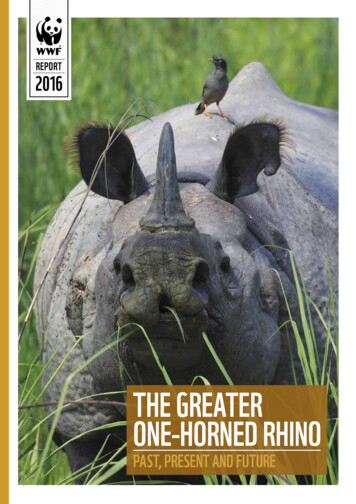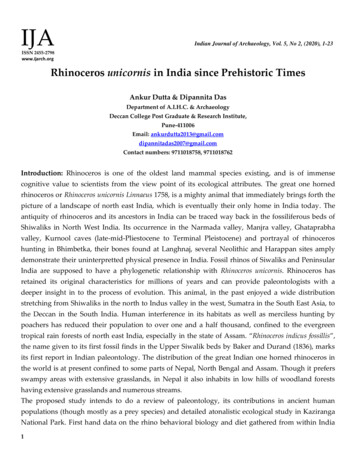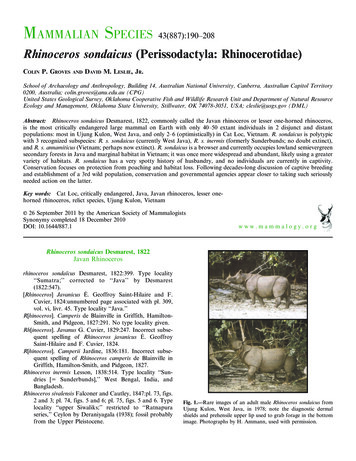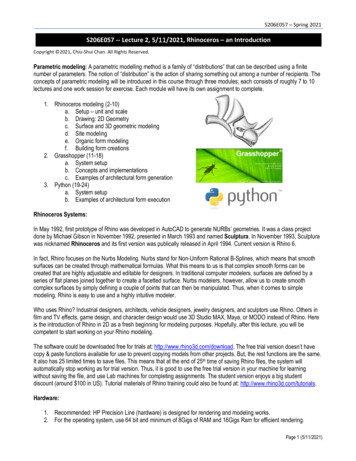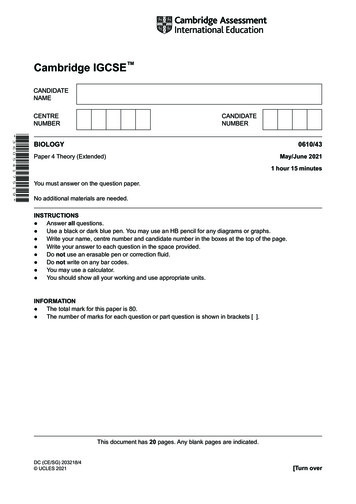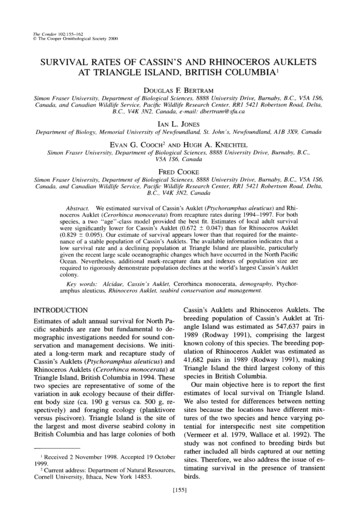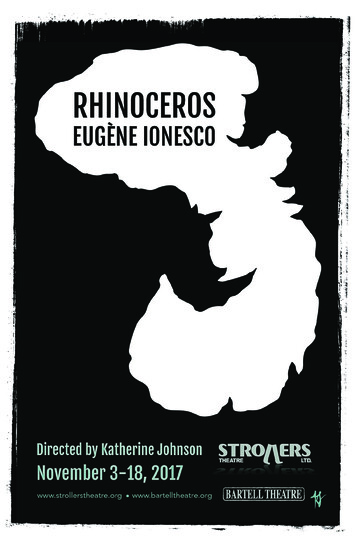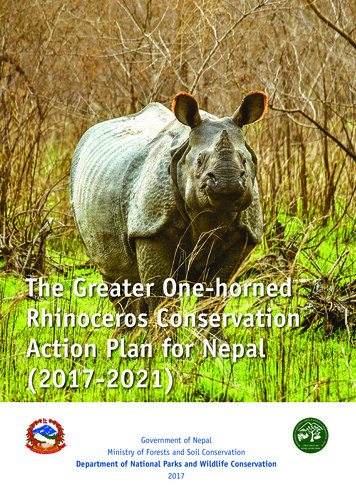
Transcription
The Greater One-hornedRhinoceros ConservationAction Plan for Nepal(2017-2021)Government of NepalMinistry of Forests and Soil ConservationDepartment of National Parks and Wildlife Conservation2017
The Greater One-horned RhinocerosConservation Action Plan for Nepal(2017-2021)Government of NepalMinistry of Forests and Soil ConservationDepartment of National Parks and Wildlife Conservation2017
Technical TeamMr. Gopal Prakash Bhattarai, Deputy Director General, Department of National Parks & Wildlife ConservationMr. Laxman Prasad Poudyal, Ecologist, Department of National Parks & Wildlife ConservationMrs. Madhuri Karki (Thapa), Planning Officer, Department of ForestsMr. Rishi Ranabhat, Assistant Ecologist, Department of National Parks & Wildlife ConservationMr. Bhupendra Prasad Yadav, Assistant Ecologist, Department of National Parks & Wildlife ConservationDr. Naresh Subedi, NTNCDr. Kanchan Thapa, WWF NepalDr. Bhagawan Raj Dahal, ZSL NepalDr. Narendra Man Babu Pradhan, Wildlife ExpertReview TeamMr. Man Bahadur Khadka, Director General, Department of National Parks & Wildlife ConservationMr. Krishna Prasad Acharya, Director General, Department of ForestsMr. Sher Singh Thagunna, Deputy Director General, DNPWCDr. Maheshwar Dhakal, Joint Secretary (Technical), Ministry of Forests and Soil ConservationDr. Buddi Sagar Poudel, Regional Forest Director, Western Regional Forest DirectorateDr. Shant Raj Jnawali, Chief of Party, Hariyo Ban Programme-II, WWF NepalPublished by:Department of National Parks and Wildlife ConservationKathmandu, Nepal.Copyright:Department of National Parks and Wildlife Conservation, Nepal (2017)Citation:DNPWC. 2017. The Greater One-horned Rhinoceros Conservation Action Plan for Nepal (2017-2021) Departmentof National Parks and Wildlife Conservation, Kathmandu, Nepal.Front Cover Photo: Muna Thapa/WWF NepalBack Cover Photo: Sagar Giri
The Greater One-horned Rhinoceros Conservation Action Plan for Nepal (2017-2021)5contents1.INTRODUCTION. 101.1. Relevance of the Action Plan Revision. 101.2. Revision Process. 111.3. Scope of the Action Plan. 112.BACKGROUND. 142.1Global Distribution of Rhinoceros. 142.2 The Greater One-horned Rhinoceros Distribution. 152.3 Ecology. 162.4 The Conservation Status of Greater One-horned Rhinoceros in Nepal. 163.REVIEW OF RHINOCEROS CONSERVATION ACTION PLAN (2006-2011). 223.1Review of Achievements. 223.2 Review of Conservation Initiative between (2011-mid 2017). 233.3 Stakeholders in Implementing the Plan. 244CONSERVATION THREATS AND CHALLENGES. 264.1Poaching and Illegal Trade in Rhino Horns. 264.2 Habitat Loss, Fragmentation and Degradation. 274.3 Infrastructure Development. 274.4 Human-Rhinoceros Conflict. 274.5 Climate Change and Natural Disasters. 274.6 Small Populations. 284.7 Wildlife Disease. 285THE GREATER ONE-HORNED RHINOCEROS CONSERVATION ACTION PLAN (2017 – 2021). 305.1Goal. 305.2 Objectives. 306PLAN IMPLEMENTATION AND MONITORING. 366.1Implementing Agency. 366.2 Financial Plan. 376.3 Monitoring of the Plan Implementation. 377MONITORING OF THE PLAN IMPLEMENTATION. 378REFERENCES. 389ANNEXES. 41
6The Greater One-horned Rhinoceros Conservation Action Plan for Nepal (2017-2021)ACRONYMS & CCBWWFZSLAnti-Poaching UnitAsian Rhino Specialist GroupBardia National ParkBuffer Zone Management CommitteeBuffer Zone User CommitteeCommunity-Based Anti-Poaching UnitConvention on Biological DiversityCentral Investigation BureauConvention on International Trade in Endangered Species of Wild Fauna & FloraChitwan National ParkDistrict Coordination CommitteeDistrict Forest OfficeDepartment of National Parks and Wildlife ConservationDepartment of ForestsFood and Agriculture Organization of the United NationsGovernment of NepalGlobal Tiger ForumInternational/Non-Governmental OrganizationInternational Union for Conservation of NatureMinistry of Forests and Soil ConservationManagement Information SystemMemorandum of UnderstandingNational ParkNational Tiger Conservation CommitteeNational Trust for Nature ConservationNational Wildlife Crime Control Coordination CommitteeProtected AreaParsa National ParkSouth Asian Association for Regional CooperationSouth Asia Wildlife Enforcement NetworkShuklaphanta National ParkSpatial Monitoring and Reporting ToolTerai Arc LandscapeUnited Nations Development ProgramUnited Nations Framework Convention on Climate ChangeUnited StatesWildlife Crime Control BureauWorld Wide Fund for NatureZoological Society of London
The Greater One-horned Rhinoceros Conservation Action Plan for Nepal (2017-2021)7Executive SummaryThe rhinoceros belongs to the family Rhinocerotidae andincludes four genera, five species and eleven subspecies.Only five species of rhinoceros are surviving in the worldof which three species namely - the greater one-hornedrhinoceros (Rhinoceros unicornis), Javan rhinoceros(Rhinoceros sondaicus) and Sumatran rhinoceros(Dicerorhinus sumatrensis) are confined in Asia andtwo species namely - the black rhinoceros (Dicerosbicornis) and white rhinoceros (Ceratotherium simum)in African continent.Until the 15th century, the greater one-horned rhinoceroswere abundant throughout the floodplains of the Ganges,Brahmaputra and Sindh Rivers and their large tributariesbetween the Indo-Burmese border in the east andPakistan in the west. At present, about 3,500 rhinocerossurvive in small isolated protected areas of Nepal andIndia. Rhinoceros suffered a catastrophic decline inNepal during 1960s due to indiscriminate poaching andhabitat destruction. As a result c.100 rhinoceros leftin Nepal by 1966. After the establishment of ChitwanNational Park (CNP) in 1973 and strict law enforcementthe rhinoceros population gradually recovered to 612 in2000 with three sub-populations. However, during adecade long armed conflict (1996 – 2006) the rhinocerospopulation declined to 408 individuals. But after therestoration of peace in Nepal the population is increasingat 5% per annum. Currently, there are 605 rhinocerosin CNP, 29 in Bardia National Park, 8 in ShuklaphantaNational Park and 3 in Parsa National Park and theirsurrounding forests totaling 645 individuals in Nepal.up of water holes and wetlands because of siltationand habitat degradation through natural succession,frequent and uncontrolled forest fires are alsoposing threats to rhinoceros conservation. Proposedlarge infrastructures construction like postal road,Karnali high dam if implemented will exert adverseimpacts on the prime rhinoceros habitats. Humanrhinoceros conflicts because of crop depredation andhuman harassment is also substantial. The small subpopulations in Bardia and Shuklaphanta NationalParks need additional supplementation to makethem viable. On the other hand, the changing climateacross the globe will put further negative pressureson the conservation of rhinoceros. However, withthe current rhinoceros conservation success inNepal there is very positive hope and enthusiasm toachieve more success in the future. In this context,the rhinoceros conservation action plan for Nepal hasbeen prepared through revision of past action plans,protected area management plans, Forest Policy(2015) and National Biodiversity Strategy and ActionPlan (2014-2020).The Greater One-horned Rhinoceros ConservationAction Plan for Nepal (2017-2021) envisions three viablepopulations of rhinoceros managed and maintained inNepal as meta-population. The plan identifies sevenstrategic objectives towards achieving this goal: Poaching and illegal trade on horns has always beenthe major threat to rhinoceros conservation. Poachingcan escalate any time though it is currently undercontrol in Nepal since 2011. Therefore, maintainingthis success is a great challenge for Nepal in the daysto come. Habitat degradation mainly due to invasiveplant species like Mikania micrantha, Chromolaenaodorata, Lantana camera and Water Hycinth, drying Strengthen national and local institutional capacityto curb poaching and illegal trade of ntationManage human rhinoceros conflict throughcommunity engagementsPolicy advocacy to safeguard prime rhinoceroshabitats from large infrastructure development andurbanizationStrengthen support and cooperation for rhinocerosconservation at national and international level
8 The Greater One-horned Rhinoceros Conservation Action Plan for Nepal (2017-2021)Enhance research, monitoring and documentationManage rhinoceros populations in a meta-populationapproachThis plan further outlines priority outcomes for each ofthe objectives and then translates these conservationobjectives and desirable outcomes into actions,measurable indicators and realistic time-frames. Theoverall indicator of success or the plan's measurable DNPWCtarget is that the rhino populations in Nepal continueto grow by 5% per annum. As the custodian of the Plan,Department of National Parks and Wildlife Conservationand Department of Forests under the Ministry of Forestsand Soil Conservation of the Government of Nepal havethe responsibility of implementing the identified actionsin collaboration with multiple conservation partners andlocal communities. Total estimated budget for the fiveyears is NPR. 646.15 million.
1The Greater One-horned Rhinoceros Conservation Action Plan for Nepal (2017-2021)9C H A P TE R - 1Introduction
10The Greater One-horned Rhinoceros Conservation Action Plan for Nepal (2017-2021)IntroductionPresently, rhino population is estimated at 645 individuals in Nepal. TheGreater One-horned Rhinoceros Conservation Action Plan for Nepal (20172021) is a continuation of the previous Action Plan (2006-2011) which aimedat maintaining a viable rhinoceros population in Nepal.1.1 Relevance of the Action Plan RevisionThe Greater One-horned Rhinoceros ConservationAction Plan (2006-2011) was accomplished in 2011. Thestrategies taken by this plan have proved to be successfulin conserving rhinoceros in Nepal as the population ofrhinoceros has increased to 534 in 2011 from 408 in 2005and achievement of zero rhino poaching year in 2011.Between 2012 and 2016 major focus was given to upscalethe anti-poaching operations, strengthen communityengagement and institutional reform. Presently, rhinopopulation is estimated at 645 individuals in Nepal.This Greater One-horned Rhinoceros ConservationAction Plan for Nepal (2017-2021) is a continuation ofthe previous Action Plan (2006-2011), which aimed atmaintaining a viable rhinoceros population in Nepal.In the changing context, all strategies have either beenupdated or are in the process of revision. In this context,the action plan has been prepared to maintain viablepopulations by addressing the threats and challenges forrhinoceros conservation in Nepal.ActionPlanTask ForceFinalization andSubmissionNational LevelConsultationsTOR DevelopmentDesk ReviewOutsourcingField ConsultationsFigure 1: Process followed in preparation of action planReview with workinggroup and experts
The Greater One-horned Rhinoceros Conservation Action Plan for Nepal (2017-2021)111.2 Revision Process1.3 Scope of the Action PlanThe action plan was developed through review of relevantliteratures, both published and unpublished, and widerconsultations at the field level as well as central levels.Field level consultative workshops were organized inall rhino bearing protected areas viz. Chitwan NationalPark (CNP), Bardia National Park (BNP), ShuklaphantaNational Park (ShNP) and Parsa National Park (PNP).The workshops included major stakeholders suchas Buffer Zone Management Committees (BZMCs),Buffer Zone User Committees (BZUCs), WWF, NTNC,ZSL Nepal, relevant government authorities includingprotected area authorities, protected area security units,District Forest Offices (DFOs), and District CoordinationCommittees (DCCs). A draft report was prepared andshared among the working group and experts for review.National level consultative workshop was organizedwith participation of the key stakeholders. All therelevant comments and suggestions were incorporatedin the final action plan.The action plan has fully adopted priorities provisionedby National Biodiversity Strategy and Action Plan (20142020), Forest Policy (2015), and Protected Area (PA)management plans of rhino bearing protected areasof Nepal. This action plan will be implemented in fourrhino bearing protected areas vis-à-vis Chitwan NationalPark, Bardia National Park, Parsa National Park, andShuklaphanta National Park and their surroundingforests.The action plan consisted of five chapters. First chapterhighlights the overall introduction, second chaptersummarizes the distribution, national and internationalstatus and ecology of rhinoceros conservation, thirdchapter reviews the rhinoceros conservation action plan(2006-2011). Fourth chapter summarizes conservationthreats and challenges of rhinoceros in Nepal. The fifthchapter deals with the Greater One-horned RhinocerosConservation Action Plan for Nepal (2017-2021).The plan is presented with goal, objectives, outputsand actions. Sixth chapter includes implementationmechanisms and monitoring plan.Time line and tentative budget for four protected areasand central level activities are presented in annex 1.
12The Greater One-horned Rhinoceros Conservation Action Plan for Nepal (2017-2021) WWF Nepal
2The Greater One-horned Rhinoceros Conservation Action Plan for Nepal (2017-2021)13C H A P TE R - 2BACKGROUND
14The Greater One-horned Rhinoceros Conservation Action Plan for Nepal (2017-2021)BACKGROUNDThe greater one-horned rhinoceros once ranged across the entire northernpart of the Indian sub-continent, along the Indus, Ganges and BrahmaputraRiver basins, from Pakistan in the west to the Indo-Burmese border in the east,including parts of Nepal, Bangladesh and Bhutan.2.1 Global Distribution of RhinocerosThe living rhinoceros belongs to the familyRhinocerotidae. It includes four genera, five speciesand eleven subspecies. At present, only five species ofrhinoceros are surviving in the world. Out of them threespecies, greater one-horned rhinoceros (Rhinocerosunicornis), Javan rhinoceros (Rhinoceros sondaicus)and Sumatran rhinoceros (Dicerorhinus sumatrensis)are confined in Asia, black rhinoceros (Diceros bicornis)and white rhinoceros (Ceratotherium simum) are foundin the African continent (Figure 2).All three species of Asian rhinoceros are now restrictedto isolated pockets of protected areas. Javan rhinocerosis the most critically endangered species with about50 individuals left in the wild in Java island ofIndonesia. Sumatran rhinoceros have also suffered a50% population decline over the last 15 years due toindiscriminate poaching and habitat loss (Amin et al.2006). The Sumatran rhinoceros populations remainin few protected areas of Indonesia and Malaysia withless than 100 individuals. There are about 3,500 greaterone-horned rhinoceros in the wild currently distributedin India and Nepal (Rookmaaker et al. 2016). Becauseof the recent recovery of rhinoceros populations inIndia and Nepal, the species has been down listed atvulnerable category (IUCN 2008).Critically endangered black rhinoceros are slowlyrecovering from a 96% declined population. Today,black rhinoceros are found in Namibia, South Africa,Kenya, Tanzania, and Zimbabwe. Small populationsi.e. less than 20 black rhinoceros are found in Malawi,Swaziland, and Zambia. At present, about 5,055 blackrhinoceros with three subspecies are surviving in thewild (IUCN, 2013). The white rhinoceros is the mostabundant species found in South Africa, Botswana,Namibia, Kenya, Zimbabwe, Swaziland, Tanzania,and Uganda. Small populations remain in Zambia,Malawi and Mozambique (Emslie 2012a, 2012b). Theoverwhelming rhinoceros conservation success story isthat of the white rhinoceros. With numbers as low as 50left in the wild in the early 1900s, the white rhinoceroshas now increased to over 20,000 and has become themost populous of all the rhinoceros species (Amin et al.2006). Despite the population increase every year, therehas been unprecedented rise in rhinoceros poachingsince 2008 which may bring the species back intodecline if poaching is not reduced.2.2 The GreaterDistributionOne-hornedRhinocerosThe greater one-horned rhinoceros (henceforthrhinoceros) is the second largest of the five extantspecies. The rhinoceros once ranged across the entirenorthern part of the Indian sub-continent, alongthe Indus, Ganges and Brahmaputra River basins, fromPakistan in the west to the Indo-Burmese border in theeast, including parts of Nepal, Bangladesh and Bhutan(Rookmaaker et al. 2016). They may have also existed
The Greater One-horned Rhinoceros Conservation Action Plan for Nepal (2017-2021)15Figure 2: Estimated number and distribution of five species of rhinoceros across the globe (source: www.savetherhino.org)in Myanmar, southern China and Indo-China. But dueto habitat loss for other land uses, excessive hunting andtrade for horns, the habitat range has sharply declined.As a result, by the 19th century, the rhinoceros wererestricted only in the Terai grasslands of southern Nepaland northern and eastern India particularly in UttarPradesh, Bihar, West Bengal and Assam. At present,their ranges have further declined and are confined inisolated pockets of protected areas in Nepal and Northeastern India (Figure 3) (Thapa et al. 2013; Rookmaakeret al. 2016)Rhinoceros are now restricted to few protected areasin India and Nepal totaling about 3,500 individuals in12 protected areas. In India, the majority are in Assam(Kaziranga, Pobitora, and Manas National Parks andOrang Wildlife Sanctuary), in West Bengal (Jaldaparaand Gorumara Wildlife Sanctuaries) and a few in UttarPradesh (Dudhwa National Park and KaterniaghatWildlife Sanctuary). In Nepal, rhinoceros occur mainlyin Chitwan National Park, Bardia National Park andShuklaphanta National Parks and their surroundingforests (Fig 3). After the relocation of settlements(Ramauli Pratapur, Rambhori Bhatta) in PNP and itsextension to the east, this has created additional suitablehabitats and rhinoceros from Chitwan have startedcolonizing the new habitats in Parsa National Park.2.3 EcologyThe greater one-horned rhinoceros is one of the moststudied large mammals in Nepal (eg. Laurie 1978,Dinerstein and Price 1991, Dinerstein 2003, Jnawali1995 and Subedi 2012, Pradhan et al. 2008, Rothley etal. 2004). Tall floodplain Terai grasslands interspersedwith riverine forests and wetlands are key habitats forrhinoceros (Dinerstein 2003, Jnawali 1995, Subedi2012). Rhinoceros is mainly a grazer. Saccharumspontaneum, Imperata cylindrica, Eragrostris tenella,Saccharum bengalensis, Narenga porphyrocoma,Phragmites karka and Cynodon dactylon are majorfood plants for rhinoceros. Average daily dry matterintake of the free ranging rhinoceros is about 24 kg andthey spent about 40% of the time on feeding (Subedi
16The Greater One-horned Rhinoceros Conservation Action Plan for Nepal (2017-2021)Figure 3: Historic and present distributions of greater one-horned rhinoceros2012). The average life expectancy of rhinoceros is 40years in the wild. The male rhinoceros becomes sexuallymatured at the age of 10 and females at age of 7. Averageinter-birth interval is 44.2 3.64 months and there isno seasonality on births and birth is distributed acrossall months (Subedi 2012). Average gestation period ofthe rhinoceros is 16 months and gives birth to a singlecalf at a time. Average annual home range in Chitwanis 20.54 6.06 km2 for male and 10.58 1.34 km2 forfemale. There is 47% overlap of home ranges betweenthe males, and a minimum of three female's homeranges overlap with the home range of a male. Homerange overlaps among females is over 60%. This factsuggests that the greater one-horned rhinoceros arenot territorial (Subedi 2012) and therefore the habitatcan accommodate many rhinoceros in a small area. Tallgrasslands, short grasslands and riverine forests are themost preferred habitats. They rarely use the Sal (Shorearobusta) forests which is most abundant across Terai.Certain k-selected traits inherent to rhinoceros i.e. largebody size, long gestation and inter-birth interval, singlecalf, and large home ranges in combination with habitatloss and environmental stochastic events make them morevulnerable to extinction events. Due to these reasons megaherbivores, especially the rhinoceros, have received globalattention since the recent past and many populations havebeen recovered in spite of ever looming threat of poachingfor their horns. Nepal has done a commendable endeavorto recover rhinoceros from the brink of extinction, sincethere were less than 100 rhinoceros left as a singlepopulation in Chitwan during 1960s (Dinerstein 2003).At present, there are 645 rhinoceros in Nepal in threesmall subpopulations and average annual growth rate is5% (DNPWC 2015). However, these rhinoceros are stillthreatened by poaching and habitat degradation causedby invasive Mikania micrantha and proposed linearinfrastructures like highway and railway (Murphy et al2013, Talukdar 2014).2.4 The Conservation Status of Greater Onehorned Rhinoceros in NepalIn Nepal, rhinoceros habitat has been protected since
The Greater One-horned Rhinoceros Conservation Action Plan for Nepal (2017-2021)900Chitwan80017NepalRhino 01994198819801975197019651960195519500YearFigure 4: The population trend of greater one-horned rhinoceros in Chitwan Valley and Nepal.1846, when the first Rana Prime Minister orderedto save rhinoceros and its habitats, primarily in theChitwan valley (Caughley 1969). In early 1950s, therewas believed to be more than 1,000 rhinoceros inNepal. In the 1950s, government launched a malariaeradication campaign and enacted a resettlementprogram. Chitwan valley was then opened for settlerscoming from the hills of Nepal, which dramaticallyincreased Chitwan’s human population and significantlychanged land use patterns. Around 70% of the forestsin Chitwan valley was destroyed and the lands wereconverted for cultivation (Caughley 1969, Laurie 1978).With the destruction of forests, wildlife poaching alsofostered. As a result, rhinoceros population dropped toless than 100 individuals during the late 1960s (Thapaet al 2013).In 1957, the country’s first conservation act WildlifeProtection Act (aka Jungalee Jiv Janthu SamrakshanAin, 2015 BS1) with promulgated for the protection ofrhinoceros and their habitat. In the early 1960s, thewestern end of the Chitwan valley and south of theRapti River was declared as a Rhino Sanctuary. Thedramatic decline of the rhino population due to severepoaching impelled the Government to institute GaidaGasti – a Rhino Patrol Unit - in 1961 with 130 armedstaff and established a network of guard posts all over1BS: Bikram SambhatChitwan. To prevent the extinction of rhinoceros,the Chitwan National Park was established in 1973,initially encompassing an area of 544 km2 whichwas later extended to 932 km2 in 1977 and furtherextended to 952.63 km2 in 2017 incorporating OldPadampur settlement areas. Because of ineffectivenessof the Rhino Patrol Unit, the Government of Nepaldeployed Nepali Army in 1975 to intensify the wildlifepatrol and surveillance. The National Parks andWildlife Conservation Act was promulgated in 1973which provided strict protection to the endangeredand protected wildlife species including rhinoceros.Effective protection and management of wildlife andtheir habitats after the establishment of ChitwanNational Park resulted in the gradual increment ofrhinoceros population to reach 466 as early as in1994 (Yonzon 1994). Chitwan National Park was theonly rhinoceros bearing area in Nepal till 1986. Withthe aim of establishing second viable population inBardia National Park, 87 rhinoceros were translocatedbetween 1986 and 2003 from Chitwan valley. Similarly,4 rhinoceros were also translocated to ShNP in 2003to create third population in Nepal. Five additionalrhinoceros were reintroduced in 2017 to supplement thissmall population. The heavy poaching of rhinoceros inBardia during the armed conflicts (1996-2006) resultedin a decline in rhinoceros population from 67 in 2000to 31 in 2007 and 29 in 2015 (DNPWC 2000, 2009 and
18The Greater One-horned Rhinoceros Conservation Action Plan for Nepal (2017-2021)2011). To supplement this population, additional 8rhinoceros have been reintroduced in Bardia NationalPark. There are 645 rhinoceros in Nepal as of nationalrhinoceros count 2015 (Figure 4). The Chitwan NationalPark holds the second largest population of Rhinocerosin the Indian sub-continent after Kaziranga NationalPark in India (Thapa et al 2013).of National Parks and Wildlife Conservation andDepartment of Forests under the Ministry of Forestsand Soil Conservation in partnership with NationalTrust for Nature Conservation (NTNC), WWF Nepal,ZSL Nepal and local communities conduct rhino countsat every 4 to 5 years to find out the population status andevaluate the effectiveness of management interventions.Recent rhino counts were carried out in 2011 and 2015and comparative sex and age composition details (Table1) are also available.The rhinoceros is listed as a protected animal by NationalParks and Wildlife Conservation Act (1973) and is alsolisted in CITES Appendix-I since 1975. The DepartmentTable 1: Age, sex and population estimates of greater one-horned rhinoceros in Nepal in 2011 and2015Count 2011Protected AreasChitwan NP andsurrounding areasBardia NP andsurrounding areasShukalphanta NP andsurrounding areaParsa Wildlife Reserveand surroundingareasSexAdultSub AdultCount 2015CalfTotalAdultSub otal Population(Source: Subedi et al 2013; DNPWC 2015)35066117534
The Greater One-horned Rhinoceros Conservation Action Plan for Nepal (2017-2021)19Figure 5: Map depicting rhino bearing protected areas and forest corridors of Nepal.Of the total 645 rhinoceros counted in 2015, about70% rhinoceros in Nepal were adults while remaining30% were calves and sub-adults. Female to male sexratio was 1.37 (n 352) and about 57% of the adultfemales had calves. A total of 111 rhinoceros increasedin Nepal between 2011 and 2015 with about 5% annualrate of population growth (DNPWC 2015). About 10%of the rhinoceros are distributed in the buffer zone andforest corridors outside the protected areas where localcommunities are taking care of these rhino
The rhinoceros belongs to the family Rhinocerotidae and includes four genera, five species and eleven subspecies. Only five species of rhinoceros are surviving in the world of which three species namely - the greater one-horned rhinoceros (Rhinoceros unicornis), Javan rhinoceros (Rhinoceros
